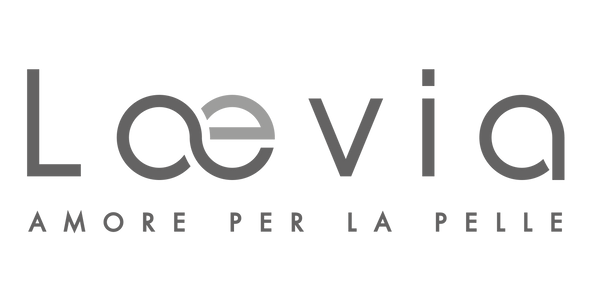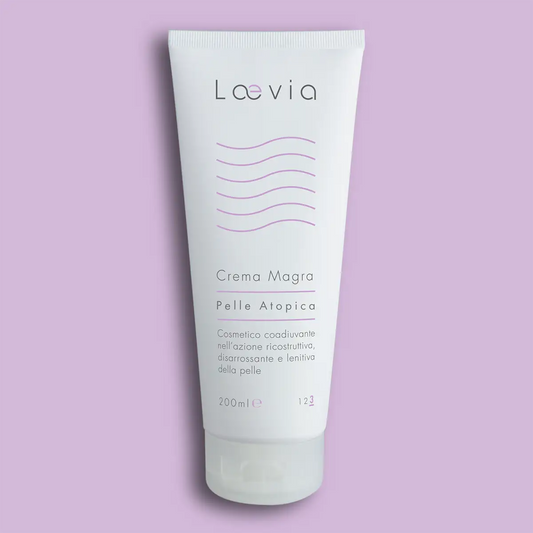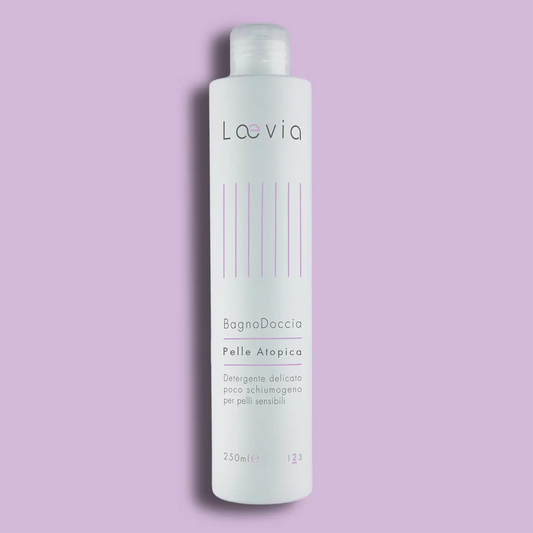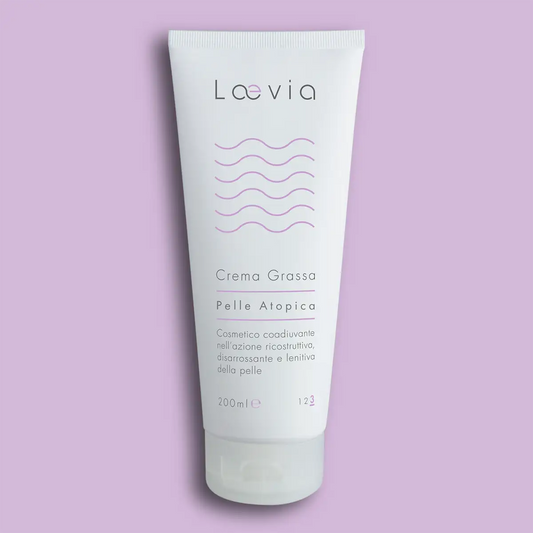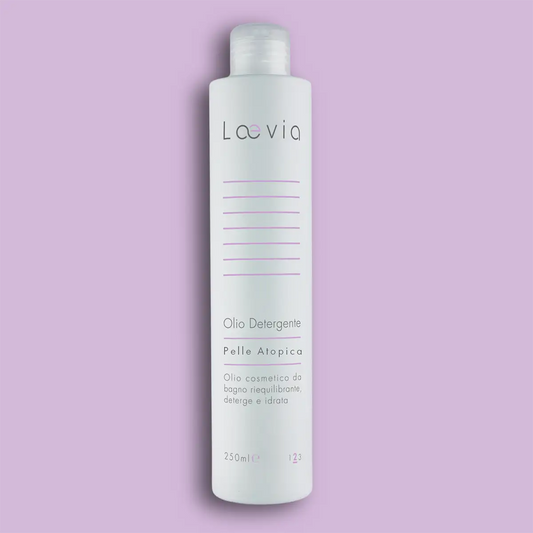Brief overview of therapies against atopic dermatitis, to always be combined with skin hydration and protection from allergens.
The perfect number in the treatment of atopic dermatitis is three.
The therapeutic approach to the itching, dryness and skin lesions of the disease involves the synergistic combination of different elements:
- From hydration, cleansing and reconstruction of the skin with suitable dermocosmetic products
- From a topical and/or systemic administration, where necessary, of targeted drugs
- From the reduction of exposure to allergens responsible for the onset of dermatitis

Correct cleansing, hydration and protection
The right approach to atopic dermatitis starts from here. In fact, cleansing and hydrating the skin are the first effective step to keep the disorder and related symptoms under control.
Let's start with personal hygiene, the bathroom in particular. There are some essential rules to respect: that is, soaking in fresh water must not be too long or excessively hot because it dries out and overheats the skin; it is better to choose a quick, warm shower or bath instead, especially if it is a child's skin that is suffering from dermatitis. Bath salts specific for atopic skin are ideal, as they help remineralize and purify the skin.
The detergent used also makes a difference: first of all it is necessary to massage, and never rub, the skin with products that have a slightly acidic pH (between 5 and 6), i.e. respectful of that of the skin, which are not perfumed or excessively foaming to avoid can irritate the skin or ruin the balance of the hydrolipidic film, our skin barrier, stimulating itching or dryness. It is essential that they are free of SLS and SLES, two surfactants that are too aggressive.
After the bath, the second action begins which brings benefits to the skin: hydration with suitable emollient creams, which reduce dryness. In addition to emollient ingredients, it is essential that the creams chosen contain elements that soothe redness and itching.
But it's all wasted effort if, after having massaged yourself all over, you wear clothing, directly in contact with the skin, made of wool or synthetic fabrics that have an irritating effect! Soft cotton or linen is much better.
Medicines: how, when and why
In parallel with cleansing, and in general with a good daily dose of skin pampering, there is pharmacological therapy. To date, there is no definitive cure for atopic dermatitis, but different therapeutic options allow for the creation of tailor-made treatments, which take into account the person's age, the intensity of the symptoms and the quality of life.
This is why it is essential that mums and dads subject the little ones to specialist medical examinations in order to adapt the therapy based on the skin response. We remember, in fact, that atopic dermatitis is a disease with a strong pediatric prevalence.
The first pharmacological approach is usually topical. That is, it consists of applying creams directly to the skin, usually based on cortisone which have an anti-inflammatory effect and antihistamine ointments useful for reducing itching. The recommendation for mums and dads is never to suddenly stop cortisone therapy, whether local or by mouth, so as not to trigger important side effects, but to reduce the dosage gradually by scrupulously following the doctor's instructions.
Topical medications should be applied after having well hydrated the skin, while in the event that a super infection is present, the application of antibiotics or antifungals is also indicated, always and only upon medical prescription.
Systemic therapy instead involves the administration of drugs by mouth. They may include immunomodulators, i.e. drugs capable of acting on the immune system, reducing its activity, or alternative active ingredients to cortisone, such as tacrolimus and pimecrolimus which reduce dryness and itching without considerable side effects. These therapies must always be agreed upon and prescribed by the attending physician.
In severe cases of atopic dermatitis, oral cortisone is used which acts quickly, but which must only be administered in cycles and for short periods, always with the agreement and prescription of the doctor or specialist treating the patient.
Systemic antihistamines are only effective for alleviating itching while antibiotics and antifungals are indicated when a superinfection is present. To avoid the chronic use of antibiotics, technological fabrics are available today, the peculiarity of which is to have fibers containing antimicrobial and antibacterial agents capable of counteracting the action of the S. Aureus bacteria, considered one of the causes of dermatitis, improving the symptoms .
Between innovation and the future
Therapeutic research never stops, and among the latest lines of treatment for atopic dermatitis it offers some biological drugs (tituximab, efalizumab, omalizumab, mepolizumab) studied on the mechanism of action of various cytokines, i.e. protein molecules, which control the disease.
In the case of rather extensive disease, among the most innovative solutions is narrow-band UVA1 and UVB phototherapy, although the benefits may vary from person to person.
Still among the latest therapeutic frontiers, this time natural, there is an active ingredient extracted from the sunflower which acts by penetrating the skin cells and integrating into the mechanisms that control the onset and severity of skin irritations.
Last but not least, or rather first and foremost, the use of probiotics is recommended. According to the international guidelines of the World Allergy Organization, the administration of probiotics during pregnancy, during breastfeeding and to the child after birth, would be able to reduce in the unborn child, especially if at high risk because the child of atopic parents, up to 50% chance of developing allergies (especially eczema, but also food and respiratory allergies).
Diet therapy
Against atopic dermatitis, attention is also needed at the table. In fact, it seems that a correct, healthy and balanced diet, of the Mediterranean type which therefore includes plenty of fruit and vegetables which provide vitamins and mineral salts, fish, vegetable fats, fibers and cereals, can help protect the skin from the onset of dermatitis.
Finally, adequate hydration should not be neglected: lots of water and few sugary drinks are what skin thirsty for liquids requires.
Skin care
What was explained a few lines above, regarding the care of the delicate skin of those suffering from Atopic Dermatitis, still remains a practice that should become part of the daily life of those with these skin problems. Consistency in implementing these simple gestures can really change your life or that of your loved one suffering from this annoying pathology.
